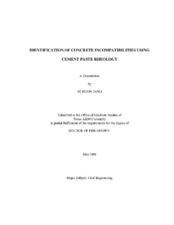| dc.contributor.advisor | Mukhopadhyay, Anal K. | |
| dc.contributor.advisor | Zollinger, Dan G. | |
| dc.creator | Jang, Se Hoon | |
| dc.date.accessioned | 2010-07-15T00:11:35Z | |
| dc.date.accessioned | 2010-07-23T21:43:11Z | |
| dc.date.available | 2010-07-15T00:11:35Z | |
| dc.date.available | 2010-07-23T21:43:11Z | |
| dc.date.created | 2009-05 | |
| dc.date.issued | 2010-07-14 | |
| dc.date.submitted | May 2009 | |
| dc.identifier.uri | https://hdl.handle.net/1969.1/ETD-TAMU-2009-05-349 | |
| dc.description.abstract | The complex interaction between cement and chemical/mineral admixtures in concrete mixtures sometimes leads to unpredictable concrete performance in the field which is generally defined as concrete incompatibilities. Cement paste rheology measurements instead of traditional workability tests (i.e., slump cone test) can have great potential in detecting those incompatibilities in concrete before the concrete is placed, which can, in turn, avoid related workability problems and setting time as well as heat evolution abnormalities. The objectives of the present study were to examine the applicability of the dynamic shear rheometer (DSR) to measure cement paste rheology, and to identify cement and mineral/chemical admixture incompatibilities, based on the determined rheological parameters.
The DSR was modified and optimized for cement paste rheology measurements. Two different modes of operations (i.e., static and dynamic methods) with the modified DSR were investigated to measure representative rheological parameters as well as to identify cement and chemical/mineral admixture incompatibility. The conventional plastic viscosity and yield stress are measured in static mode and storage modulus curve, as a function of time, is measured in dynamic mode. The rate of change of plastic viscosity (RPV) as another static rheological parameter and the modeled magnitude parameter ?, from the dynamic rheological method, showed great potentialities as acceptance criteria to identify incompatible mixtures. The heat of hydration data from isothermal conduction calorimeter tests and setting time results for the studied mixtures have strongly supported the rheology based observations as supporting tools. Based on the main tests results, the acceptance criteria were set up using the rheological parameters in accordance with heat of hydration data. This will ultimately help material suppliers, concrete producers, and other users to detect problematic combinations of concrete ingredients before a given concrete mixture is placed. | en |
| dc.format.mimetype | application/pdf | |
| dc.language.iso | eng | |
| dc.subject | incompatibility, cement paste, rheology, conduction calorimetry, mini slump cone, chemical admixture, mineral admixture, plastic viscosity, yield stress, heat of hydration, | en |
| dc.title | Identification of Concrete Incompatibilities Using Cement Paste Rheology | en |
| dc.type | Book | en |
| dc.type | Thesis | en |
| thesis.degree.department | Civil Engineering | en |
| thesis.degree.discipline | Civil Engineering | en |
| thesis.degree.grantor | Texas A&M University | en |
| thesis.degree.name | Doctor of Philosophy | en |
| thesis.degree.level | Doctoral | en |
| dc.contributor.committeeMember | Grasley, Zachary | |
| dc.contributor.committeeMember | Haque, Mohammed | |
| dc.type.genre | Electronic Dissertation | en |
| dc.type.material | text | en |


